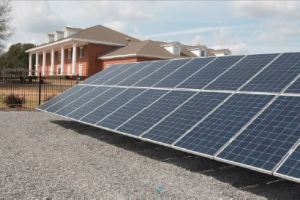Solar Energy and LED Lighting: Good for the Environment and Your Bottom Line
Solar Energy and LED Lighting: Good for the Environment and Your Bottom Line
 Every business searches for efficiencies to reduce costs and increase profits. What if these efficiencies can also benefit the environment? Partners for Environmental Progress members are showing us just how cost-effective it can be to make a positive environmental impact by adopting LED lighting and solar energy. What can be more sustainable?
Every business searches for efficiencies to reduce costs and increase profits. What if these efficiencies can also benefit the environment? Partners for Environmental Progress members are showing us just how cost-effective it can be to make a positive environmental impact by adopting LED lighting and solar energy. What can be more sustainable?
Saving with LED Lights
When considering the switch from traditional to LED lighting, it is important to think beyond the light bulb in calculating energy savings. Yes, LED lights use less energy, but they also produce less heat, last longer, and are cheaper to replace than many traditional lighting sources.
When Wesco Gas and Welding Supply decided to replace all of the metal halide light bulbs in their service areas with LED light bulbs they expected to save money on lighting and they did, reducing kilowatt usage by 40%. But the additional costs savings are equally significant. The switch to LED has led to reduced cooling expenses for the facility. The cumulative savings in energy consumption exceeded expectations, with an estimated annual reduction of $8,755 for electricity bills.
The Arkema chemical manufacturing site in Axis, Alabama also made the switch, replacing high pressure sodium, metal halide and fluorescent lights with more energy efficient LED fixtures. The change not only represents an expected energy savings of 151 megawatt hours per year, or $15,000 annually, it also results in 113 tons of reduced CO2 emissions to the atmosphere. They also found an immediate improvement in light quality to create a safer working environment for employees.
Both companies anticipate even greater savings as LED lights require less frequent replacement and cost significantly less than high pressure sodium and metal halide bulbs. LED lights also have a variety of applications beyond indoor lighting. Revitalize your signs and advertisements with low-cost LED in a range of colors. LED lights tolerate cold temperatures, so you can put them to work in cold-storage facilities and freezers. And don’t forget outdoor lighting fixtures when replacing bulbs. LED’s are perfect for architectural lighting and illuminating parking areas and walkways.
Learn more about how to make the switch and save money and resources with LED lighting here.
Making the Switch to Solar
Solar energy is the most important and widely available source of renewable energy available in today’s market. The environmental benefits of solar energy are well known: solar energy provides a safe, renewable source of energy that reduces harmful greenhouse gas emissions, shrinks the carbon footprint, and doesn’t put a strain on water resources. The economic benefits of solar energy are less understood. In fact, for years the high cost of solar has prevented many businesses as well as homeowners from making the switch to solar. But the economics are changing.
With ever-decreasing infrastructure costs and available tax credits through federal, state, and local rebates, the up-front costs of adopting renewable solar energy has never been more affordable. And with the long-term savings in energy expenses, switching to solar makes sense from an economic standpoint.
Gulf Coast Office Products made the switch in 2016. Installing a 124,135-watt Solar Energy System to power the 38,000 square-foot corporate showroom and warehouse facility in Pensacola required a capital investment of $235,000. But John Wright, owner and general manager of GCOP anticipates a 3-5 year return on investment with the savings through tax credits and reduced utility costs. “When you think about that reduction happening year after year for the next 25‐30 years we know we are making a significant contribution to our local environment and our bottom line.” John said of the project. “It’s a win‐win.”
Hargrove Engineers + Constructors were retained by the Alabama Municipal Electric Authority (AMEA) to install a 50kW solar array at AMEA’s new corporate office building in Montgomery. The project was designed to meet two initiatives: meet the power demands of AMEA’s new building and serve as a pilot project for studying the effectiveness of modular unit solar power generation for AMEA’s Member systems and their customers.
The suns’ capacity to power your business reaches far beyond solar panels on the roof. Consider replacing outdoor lights with solar-powered fixtures. Or use the sun itself to illuminate interior spaces with skylights as Daphne Utilities did in their new water treatment facility. Harness the thermal energy of the sun to heat water or provide passive heating for building spaces. With so many cost-savings options available, doing good for the environment has never been so affordable.
Recent Posts
Thompson Engineering Announces Spanish Fort Office Addition
Thompson Engineering has opened a branch office in Spanish Fort, Ala.
Applications Open for the MAWSS 2024 Citizens Water Academy
Discover the inner workings of the Mobile Area Water and
PEP Talk – Community Quarterly Newsletter
We’re excited to share the first PEP Talk – our
Challenges and Triumphs: Electrifying the Future of Tugboat Design
During PEP’s March Member Breakfast, our speakers discussed the current
Outokumpu Makes Corporate Knight’s List of Clean200
Another PEP member is in the news for their work
